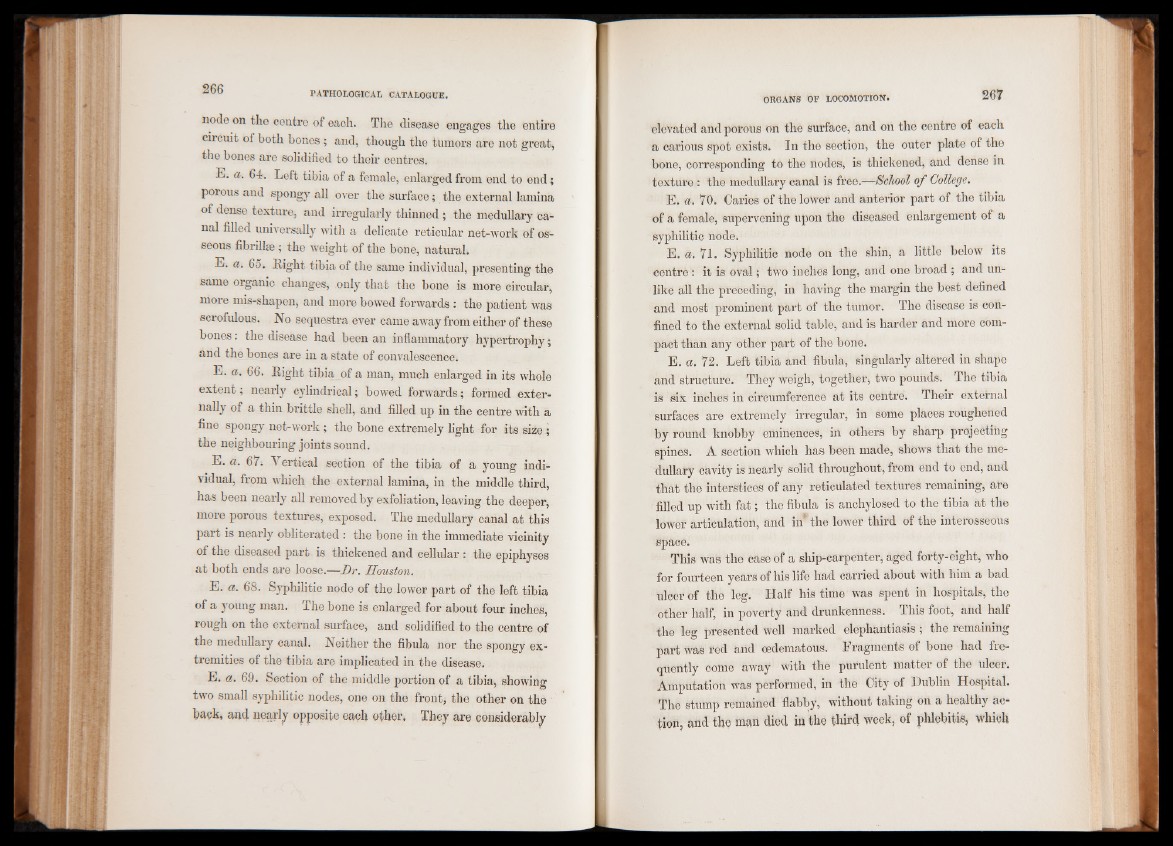
node on the centre of each. The disease engages the entire
circuit of both bones; and, though the tumors are not greats
the bones are solidified to their centres.
E. a. 64. Left tibia of a female, enlarged from end to end;
porous and spongy all over the surface; the external lamina
of dense texture, and irregularly thinned ; the medullary canal
filled universally with a delicate reticular net-work of osseous
fibrillse ; the weight of the bone, natural.
E. a. 65. Right tibia of the same individual, presenting the
same organic changes, only that the bone is more circular,
more mis-shapen, and more bowed forwards : the patient was
scrofulous. No sequestra ever came away from either of these
bones: the disease had been an inflammatory hypertrophy 5
and the bones are in a state of convalescence,
E. a. 66. Right tibia of a man, much enlarged in its whole
extent; nearly cylindrical; bowed forwards; formed externally
of a thin brittle shell, and filled up in the centre with a
fine spongy net-work ; the bone extremely light for its size;
the neighbouring joints sound.
E. a. 67, Vertical section of the tibia of a young individual,
from which the external lamina, in the middle third,
has been nearly all removed by exfoliation, leaving the deeper,
more porous textures, exposed. The medullary canal at this
part is nearly obliterated : the bone in the immediate vicinity
of the diseased part is thickened and cellular : the epiphyses
at both ends are loose.—Dr. Houston.
E. a. 68. Syphilitic node of the lower part of the left tibia
of a young man. The bone is enlarged for about four inches,
rough on the external surface, and solidified to the centre of
the medullary canal. Neither the fibula nor the spongy extremities
of the tibia are implicated in the disease.
E. a. 69. Section of the middle portion of a tibia, showing
two small syphilitic nodes, one on the front, the other on the
back, and nearly opposite each other. They are considerably
elevated and porous on the surface, and on the centre of each
a carious spot exists. In the section, the outer plate of the
bone, corresponding to the nodes, is thickened, and dense in
texture : the medullary canal is free.—School of College.
E. a. 70, Caries of the lower and anterior part of the tibia
of a female, supervening upon the diseased enlargement of a
syphilitic node.
E. a. 71. Syphilitic node on the shin, a little below its
centre : it is oval; two inches long, and one broad ; and unlike
all the preceding, in having the margin the best defined
and most prominent part of the tumor. The disease is confined
to the external solid table, and is harder and more compact
than any other part of the bone.
E. a. 72. Left tibia and fibula, singularly altered in shape
and structure. They weigh, together, two pounds. The tibia
is six inches in circumference at its centre. Their external
surfaces are extremely irregular, in some places roughened
by round knobby eminences, in others by sharp projecting
spines. A section which has been made, shows that the medullary
cavity is nearly solid throughout, from end to end, and
that the interstices of any reticulated textures remaining, are
filled up with fat; the fibula is anchylosed to the tibia at the
lower articulation, and in#the lower third of the interosseous
Space.
This was the case of a ship-carpenter, aged forty-eight, who
for fourteen years of his life had carried about with him a bad
ulcer of the leg. Half his time was spent in hospitals, the
other half, in poverty and drunkenness, This foot, and half
the leg presented well marked elephantiasis; the remaining
part was red and oedematous. Fragments of bone had frequently
come away with the purulent matter of the ulcer.
Amputation was performed, in the City of Dublin Hospital.
The stump remained flabby, without taking on a healthy action,
and the man died in the third week, of phlebitis, which